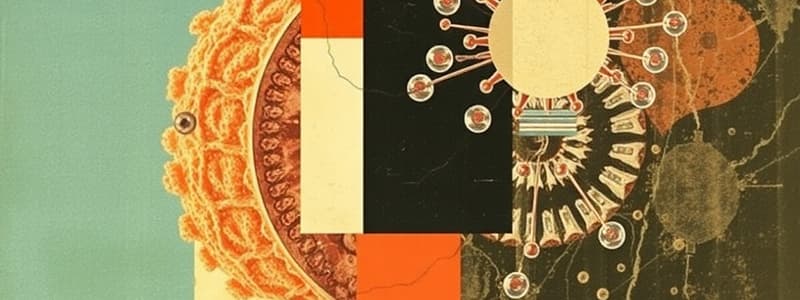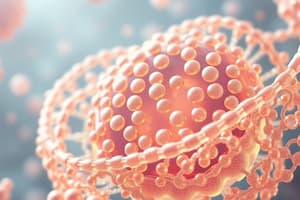Podcast
Questions and Answers
Which of the following is a primary function of the cell membrane?
Which of the following is a primary function of the cell membrane?
- Energy production
- DNA replication
- Regulating the movement of materials (correct)
- Protein synthesis
Which property of the cell membrane allows it to change shape?
Which property of the cell membrane allows it to change shape?
- Stiffness
- Flexibility (correct)
- Impermeability
- Rigidity
The ability of membrane lipids and proteins to move within the bilayer is known as:
The ability of membrane lipids and proteins to move within the bilayer is known as:
- Rigidity
- Permeability
- Fluidity (correct)
- Viscosity
Eukaryotic cells use compartmentalization to:
Eukaryotic cells use compartmentalization to:
The most abundant lipids in the cell membrane are:
The most abundant lipids in the cell membrane are:
Which of the following is a major component of animal cell membranes?
Which of the following is a major component of animal cell membranes?
Proteins that span the entire lipid bilayer are called:
Proteins that span the entire lipid bilayer are called:
Which of the following is NOT a component of the cell membrane?
Which of the following is NOT a component of the cell membrane?
The lipid bilayer is primarily composed of:
The lipid bilayer is primarily composed of:
In a lipid bilayer, the hydrophilic heads of phospholipids face:
In a lipid bilayer, the hydrophilic heads of phospholipids face:
The hydrophobic portion of a phospholipid molecule is the:
The hydrophobic portion of a phospholipid molecule is the:
Lipid bilayers spontaneously form sealed compartments in aqueous environments to:
Lipid bilayers spontaneously form sealed compartments in aqueous environments to:
The movement of molecules from an area of high concentration to an area of low concentration is called:
The movement of molecules from an area of high concentration to an area of low concentration is called:
Which of the following does NOT require energy?
Which of the following does NOT require energy?
In facilitated diffusion, a solute moves across the membrane with the help of:
In facilitated diffusion, a solute moves across the membrane with the help of:
The rate of transport in simple diffusion is directly proportional to:
The rate of transport in simple diffusion is directly proportional to:
The rate of transport in facilitated diffusion is limited by:
The rate of transport in facilitated diffusion is limited by:
The transport of a single molecule across a membrane is called:
The transport of a single molecule across a membrane is called:
The transport of two different molecules in the same direction is called:
The transport of two different molecules in the same direction is called:
The transport of two different molecules in opposite directions is called:
The transport of two different molecules in opposite directions is called:
The Na+/K+ ATPase pump is an example of:
The Na+/K+ ATPase pump is an example of:
The Na+/K+ ATPase pump transports:
The Na+/K+ ATPase pump transports:
The energy for primary active transport comes from:
The energy for primary active transport comes from:
Secondary active transport uses energy from:
Secondary active transport uses energy from:
Tertiary active transport is driven by the gradient created by
Tertiary active transport is driven by the gradient created by
The cytoskeleton is a network of protein filaments located in the:
The cytoskeleton is a network of protein filaments located in the:
Which of the following is NOT a function of the cytoskeleton?
Which of the following is NOT a function of the cytoskeleton?
Which of the following is NOT a type of cytoskeletal filament?
Which of the following is NOT a type of cytoskeletal filament?
Actin filaments are composed of:
Actin filaments are composed of:
Microtubules are composed of:
Microtubules are composed of:
Intermediate filaments are:
Intermediate filaments are:
Actin filaments are involved in:
Actin filaments are involved in:
Microtubules are involved in:
Microtubules are involved in:
Intermediate filaments primarily provide:
Intermediate filaments primarily provide:
Actin monomers bind to:
Actin monomers bind to:
The process of actin monomers adding to the ends of filaments is called:
The process of actin monomers adding to the ends of filaments is called:
Proteins that bind actin filaments and alter their assembly and organization are called:
Proteins that bind actin filaments and alter their assembly and organization are called:
Myosin is a motor protein associated with:
Myosin is a motor protein associated with:
Muscle contraction is driven by:
Muscle contraction is driven by:
During muscle contraction, calcium ions bind to:
During muscle contraction, calcium ions bind to:
The basic contractile unit of a muscle cell is the:
The basic contractile unit of a muscle cell is the:
The motor proteins associated with microtubules are:
The motor proteins associated with microtubules are:
Kinesin moves cargo towards the:
Kinesin moves cargo towards the:
Dynein moves cargo towards the:
Dynein moves cargo towards the:
Microtubules originate from a specific cellular location known as the:
Microtubules originate from a specific cellular location known as the:
In animal cells, the main MTOC is the:
In animal cells, the main MTOC is the:
The centrosome is composed of:
The centrosome is composed of:
During cell division, microtubules form the:
During cell division, microtubules form the:
Flashcards
Cell membrane primary function?
Cell membrane primary function?
Regulating the movement of materials into and out of the cell.
Cell membrane flexibility?
Cell membrane flexibility?
The cell membrane's ability to alter its shape.
Membrane fluidity?
Membrane fluidity?
Describes membrane lipids and proteins ability to move within the bilayer.
Why compartmentalization?
Why compartmentalization?
Signup and view all the flashcards
Most abundant membrane lipids?
Most abundant membrane lipids?
Signup and view all the flashcards
Cholesterol's role?
Cholesterol's role?
Signup and view all the flashcards
Integral proteins?
Integral proteins?
Signup and view all the flashcards
Nucleic acids location?
Nucleic acids location?
Signup and view all the flashcards
Lipid bilayer composition?
Lipid bilayer composition?
Signup and view all the flashcards
Hydrophilic heads face...?
Hydrophilic heads face...?
Signup and view all the flashcards
Phospholipid tail type?
Phospholipid tail type?
Signup and view all the flashcards
Why lipid bilayers?
Why lipid bilayers?
Signup and view all the flashcards
Passive transport?
Passive transport?
Signup and view all the flashcards
Ex. of transport no energy?
Ex. of transport no energy?
Signup and view all the flashcards
Facilitated diffusion needs?
Facilitated diffusion needs?
Signup and view all the flashcards
Simple diffusion rate?
Simple diffusion rate?
Signup and view all the flashcards
Transport limited by?
Transport limited by?
Signup and view all the flashcards
Uniport transport definition
Uniport transport definition
Signup and view all the flashcards
What is symport?
What is symport?
Signup and view all the flashcards
Na+/K+ pump transports?
Na+/K+ pump transports?
Signup and view all the flashcards
Study Notes
Cell Membrane Functions
- The primary function of the cell membrane is to regulate the movement of materials in and out of the cell.
- Flexibility is the property that allows the cell membrane to change shape.
- The fluidity of the cell membrane is the ability of membrane lipids and proteins to move within the bilayer.
- Eukaryotic cells use compartmentalization to separate opposing processes.
- Phospholipids are the most abundant lipids in the cell membrane.
- Cholesterol is a major component of animal cell membranes.
- Integral proteins span the entire lipid bilayer.
- Nucleic acids aren't a component of the cell membrane.
- The lipid bilayer primarily consists of phospholipids.
- The hydrophilic heads of phospholipids face the extracellular and intracellular environments in a lipid bilayer.
- Fatty acid tails form the hydrophobic portion of a phospholipid molecule.
- Lipid bilayers spontaneously form sealed compartments in aqueous environments to maximize the interaction of polar heads with water
Membrane Transport
- Passive transport is the movement of molecules from an area of high concentration to an area of low concentration.
- Facilitated diffusion does not requireenergy.
- A transport protein helps a solute move across the membrane during facilitated diffusion.
- The concentration gradient is directly proportional to the rate of transport in simple diffusion.
- The number of available transport proteins limits the rate of transport in facilitated diffusion.
- Uniport is the transport of a single molecule across a membrane.
- Symport is the transport of two different molecules in the same direction.
- Antiport is the transport of two different molecules in opposite directions.
- The Na+/K+ ATPase pump is an example of antiport.
- The Na+/K+ ATPase pump transports 3 Na+ ions out of the cell and 2 K+ ions into the cell.
- ATP hydrolysis provides the energy for primary active transport.
- An electrochemical gradient of another solute provides the energy for secondary active transport.
- An electrochemical gradient of another solute drives tertiary active transport.
Cytoskeleton
- The cytoskeleton is a network of protein filaments located in the cytoplasm.
- DNA replication isn't a function of the cytoskeleton.
- Myosin filaments aren't a type of cytoskeletal filament.
- Actin isn't what actin filaments are composed of.
- Tubulin is what microtubules are composed of.
- Intermediate filaments are rope-like fibers.
- Muscle contraction is an activity actin filaments are involved in.
- Muscle contraction is an activity microtubules are involved in.
- Intermediate filaments primarily provide mechanical strength.
- Actin monomers bind to ATP.
- Polymerization is the process of actin monomers adding to the ends of filaments.
- Motor proteins bind to actin filaments and alter their assembly and organization.
- Actin filaments are what myosin is a motor protein associated with.
- Myosin walking along actin filaments drives muscle contraction.
- Calcium ions bind to troponin during muscle contraction.
- The sarcomere is the basic contractile unit of a muscle cell.
- Kinesin and dynein are the motor proteins associated with microtubules.
- Kinesin moves cargo towards the plus (+) end of microtubules.
- Dynein moves cargo towards the minus (-) end of microtubules.
- Microtubules originate from a specific cellular location known as the microtubule-organizing center (MTOC).
- The centrosome is the main MTOC in animal cells.
- Two centrioles make up the centrosome.
- During cell division, microtubules form the mitotic spindle.
Studying That Suits You
Use AI to generate personalized quizzes and flashcards to suit your learning preferences.




